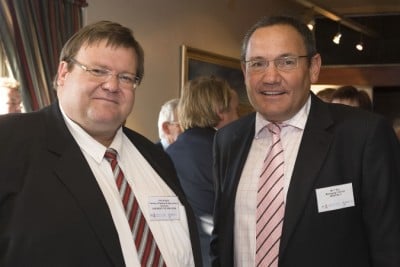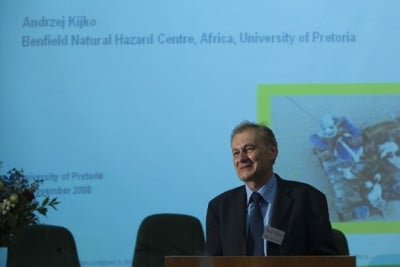According to Prof Pistorius, the Benfield Natural Centre, Africa, was formed in collaboration between Benfield, a global independent reinsurance and risk intermediary, and the University of Pretoria, one of the leading research universities in South Africa.
Prof Anton Ströh, Dean of the Faculty of Natural and Agricultural Sciences, explained that the centre aims to bring different disciplines together to work on innovative solutions for natural hazards. “It is usually at the intersection of such disciplines that innovative explosions take place. The centre will draw the expertise from Geology, Geography, Statistics, Geoinformatics and Metereology, Mathematics and Applied Mathematics, Insurance and Actuarial Sciences,” Prof Ströh said.
In his keynote address, Prof
Andrzej Kijko, Director of the Benfield Natural Hazard Centre, Africa, declared that the risks posed by natural and human-induced hazards were rapidly increasing worldwide. The frequency of natural disasters increased 30-fold in the last 50 years.
Prof Kijko told local and international guests that Africa is the only continent whose actual share of reported disasters had increased over the past decade. Contributing factors that heighten Africa’s high vulnerability to disasters include accelerating population growth, food insecurity, complex poverty, incorrect usages of natural resources and failure of policy and institutional frameworks.
“Like the University of Pretoria in its Centenary year and our partner Benfield, the African [Benfield Natural Hazard] Centre, knows no bounds in its ambitions. The study of natural disasters is vital for the future. Where there is growth and change, we will be there to predict and plan,” said Prof Kijko.
Prof Pistorius earlier stressed how important collaboration with industries and the University are – not only in assisting to position the University as a world-class institution, but also to specifically focus on the upliftment of the African continent at large. “The Centre will assist in creating the point of intersection whereby academia reaches out to the various sectors with the aim to predict and lower the risks involved in various natural hazards that causes the unnecessary loss of so many lives," he said.
Prof Pistorius indicated that the Benfield Natural Hazard Centre, Africa, would act as a multidisciplinary platform where postgraduate students and researchers could find sensible solutions for the African continent.
“The development of centres that combine excellent research activities and the development of postgraduate students with a direct engagement with the private sector are particularly valued by the University. Through these activities the University is able to foster its research agenda while, at the same time, making a direct contribution to a field with immediate practical benefits for the country,” said Professor Robin Crewe, Vice-Principal of Research & Postgraduate Studies at the University of Pretoria.
The Benfield Natural Hazard Centre, Africa, will be led by the University’s Professor Andrzej Kijko in close conjunction with Benfield’s South African office and the Benfield ReMetrics team. Professor Kijko has extensive skills in earthquake hazard modelling, mining catastrophe, and flood and meteorological risk.
“Benfield has a long history of sponsoring academic research and creating links with world-leading scientific research organizations”, said Grahame Chilton, Chief Executive of Benfield.
“The establishment of the Natural Hazard Centre, Africa, corresponds with our objective to create local centres of expertise which support our global business. This allows us to provide customers with independent technical expertise and knowledge of the natural hazard risks they may face for specific countries or territories.”
The establishment of the Centre at the University of Pretoria formalizes a long-standing relationship between Benfield and Professor Kijko, which began during the development of Benfield’s GAPQuake South Africa model in 2003. As well as continuing to improve and enhance the quality of GAPQuake South Africa, the Centre will be assisting Benfield to extend its suite of GAP models. This will include a South African hail model which will be similar to those developed by Benfield for European storms.
According to Terry Ray, Managing Director of Benfield (South Africa) (Pty) Ltd, Africa is exposed to several types of natural hazard, including earthquake, windstorm, hail and flood.
“However, the relatively small number of catastrophe claims means the region is currently low on the catastrophe modelling companies’ list of priorities, despite the potential exposure,” said Mr Ray. “This new centre forms part of our commitment to improve the understanding of natural hazard risk for Africa through the promotion of research into natural hazards that is of relevance to the local re/insurance community.”
 Dean of the Faculty of Natural and Agricultural Science, Prof Anton Ströh, and
Dean of the Faculty of Natural and Agricultural Science, Prof Anton Ströh, and
Mr Terry Ray, MD of Benfield SA
 Prof Andrzej Kijko, Director, delivers the Opening Address
Prof Andrzej Kijko, Director, delivers the Opening Address


Get Social With Us
Download the UP Mobile App